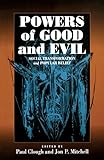Powers of Good and Evil : Social Transformation and Popular Belief / ed. by Jon P. Mitchell, Paul Clough.
Material type: TextPublisher: New York ; Oxford : Berghahn Books, [2001]Copyright date: ©2001Description: 1 online resource (264 p.)Content type:
TextPublisher: New York ; Oxford : Berghahn Books, [2001]Copyright date: ©2001Description: 1 online resource (264 p.)Content type: - 9781571813138
- 9781782387565
- 306.4 21/eng
- GN468
- online - DeGruyter
| Item type | Current library | Call number | URL | Status | Notes | Barcode | |
|---|---|---|---|---|---|---|---|
 eBook
eBook
|
Biblioteca "Angelicum" Pont. Univ. S.Tommaso d'Aquino Nuvola online | online - DeGruyter (Browse shelf(Opens below)) | Online access | Not for loan (Accesso limitato) | Accesso per gli utenti autorizzati / Access for authorized users | (dgr)9781782387565 |
Frontmatter -- Contents -- List of Illustrations -- Contributors -- Introduction -- 1 Dangerous Creatures and the Enchantment of Modern Life -- 2 Witchcraft and New Forms of Wealth: Regional Variations in South and West Cameroon -- 3 The Devil, Satanism and the Evil Eye in Contemporary Malta -- 4 ‘You Devil, go away from me!’ Pentecostalist African Christianity and the Powers of Good and Evil -- 5 Modernity, Crisis and the Rise of Charismatic Catholicism in the Maltese Islands -- 6 Good, Evil and Godhood: Mormon Morality in the Material World -- 7 The State and the Empire of Evil -- 8 The Iconography of Evil in Maltese Art -- Conclusions: The Political Economy behind the Powers of Good and Evil -- Index
restricted access online access with authorization star
http://purl.org/coar/access_right/c_16ec
A key theme in the anthropology of beliefs is the relationship between socio-economic change and changes in the belief system. It has been widely argued that rapid economic change, particularly the introduction of capitalism, leads to an increase in beliefs in, and representations of, evil and the devil. These beliefs, it is argued, constitute forms of resistance to, or rejection of, "modernity." This volume builds on these arguments, suggesting that rather than an indigenous resistance to capitalism, such representations signal a profound moral ambivalence towards the socio-economic process inherent in capitalist economy. Using a range of examples, from Surinamese zombies to American horror films, it demonstrates the extent to which evil imagery is linked to a fear of excess, particularly in situations where people find themselves, or perceive themselves, to be peripheral to the centers of political, economic, and cultural power.
Mode of access: Internet via World Wide Web.
In English.
Description based on online resource; title from PDF title page (publisher's Web site, viewed 25. Jun 2024)


